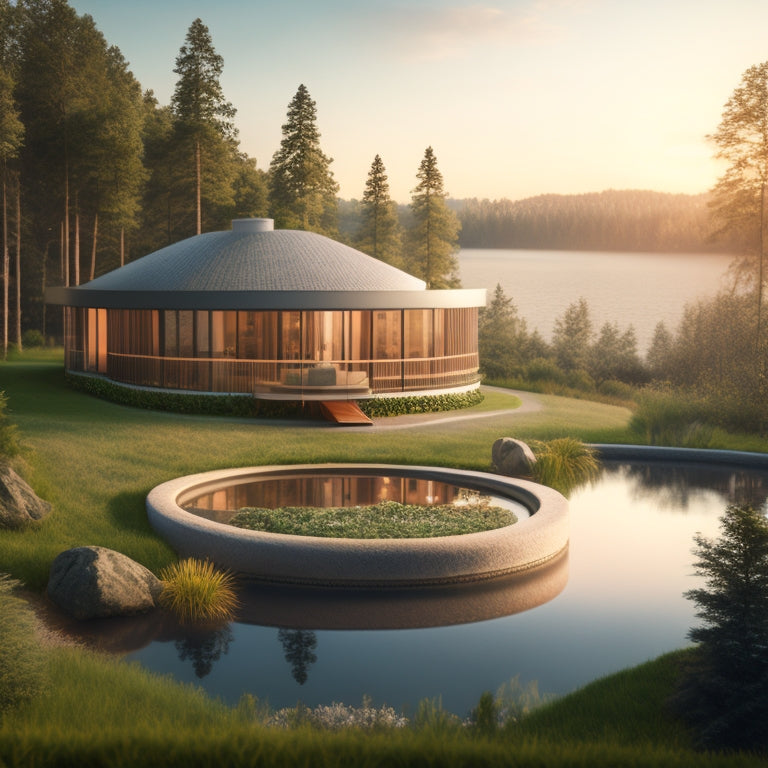
Geothermal Cooling: Efficient Water Use for Home Comfort
Share
By leveraging the earth's constant temperature, a geothermal cooling system can reduce your energy consumption and environmental impact by up to 70%. This efficient water use for home comfort is achieved through a heat exchange process that cools your home, minimizing water usage and relying on renewable energy. With time-of-use rate strategies, rainwater harvesting, and greywater recycling, you can optimize energy costs and reduce water waste. Not only will you enjoy a comfortable home, but you'll also contribute to a sustainable future. As you investigate the benefits of geothermal cooling, you'll uncover even more ways to maximize its efficiency and eco-friendliness.
Key Takeaways
- Geothermal cooling systems prioritize water efficiency, minimizing environmental impact by using ponds/lakes as heat sinks and optimizing pipe sizes and layouts.
- Nearly 70% of water usage in geothermal systems is for cooling, making time-of-use rate strategies, rainwater harvesting, and greywater recycling essential for operational efficiency.
- Closed-loop systems and optimized pump sizing minimize water usage in ground source cooling, with typical requirements of 1.5 gallons of water per ton-hour of cooling.
- Efficient system design, including ground loop, heat pump, and distribution system, considers load requirements, climate, and soil conditions to reduce water consumption and energy bills.
- Geothermal cooling systems contribute to eco-friendly living, reducing water consumption and alleviating strain on resources, which helps address global water scarcity.
How Geothermal Cooling Works
The earth's natural temperature, a constant 50-60°F (10-15°C) beneath the surface, serves as a heat sink for geothermal cooling systems. You can utilize this natural energy by circulating a fluid through underground pipes, allowing heat to transfer from your home to the earth.
This heat exchange process cools your home, providing a comfortable living space while reducing energy consumption. By leveraging renewable energy solutions, such as geothermal energy, you can minimize your reliance on fossil fuels and reduce your carbon footprint.
Geothermal cooling systems achieve high energy efficiency by taking advantage of the earth's constant temperature, reducing the need for fossil fuels and supporting a more sustainable future.
Water Efficiency in Geothermal Systems
When designing a geothermal cooling system, you'll want to prioritize water efficiency to minimize environmental impact and reduce operating costs.
By implementing water conservation methods, such as using ponds or lakes as a heat sink, you can considerably decrease water usage.
Incorporating efficient system design principles, like optimizing pipe sizes and layouts, can also help reduce water waste and maximize system performance.
Additionally, utilizing renewable energy sources for EV charging, such as solar-powered fast charging, can further enhance the eco-friendliness of the system.
Water Conservation Methods
Nearly 70% of a geothermal system's water usage is dedicated to cooling the refrigerant, making water conservation an essential aspect of its operation.
To reduce energy costs, consider implementing time-of-use rate strategies that optimize charging during off-peak hours.
You can implement water conservation methods to minimize your system's water footprint.
Consider rainwater harvesting, which collects and stores rainwater for non-potable uses like flushing toilets or washing cars.
Greywater recycling is another option, reusing water from sinks, showers, and washing machines for irrigation and toilet flushing.
Drought-resistant landscaping reduces water consumption for outdoor spaces, while sustainable plumbing fixtures and appliances help minimize water waste.
Efficient System Design
Enhancing your geothermal system's design is crucial for minimizing water usage and maximizing efficiency. When designing your system, you'll need to take into account several key components, including the ground loop, heat pump, and distribution system. Each of these components must be carefully selected and sized to guarantee peak performance and water efficiency.
Design considerations include the system's load requirements, local climate, and soil conditions. Additionally, incorporating high-efficiency solar panels Scalable Solar Systems can provide a reliable source of renewable energy, reducing the system's carbon footprint. By leveraging advanced storage solutions, you can secure a consistent energy supply and minimize downtime.
You'll also need to determine the most effective configuration for your system, such as a horizontal or vertical ground loop, and decide on the type of heat pump and distribution system to use. By carefully evaluating these factors, you can create a system that provides reliable, efficient cooling while minimizing its impact on the environment.
Ground Source Cooling Water Usage
You'll want to reflect on the water usage implications of ground source cooling systems, as they require a significant amount of water to operate efficiently.
To minimize environmental impact, it's crucial to implement water conservation methods, such as using a closed-loop system or optimizing pump sizing.
Additionally, integrating renewable energy sources, like solar energy, can reduce the system's carbon footprint and enhance energy independence.
Water Conservation Methods
As you consider implementing ground source cooling systems, it's vital to examine the water conservation methods that accompany this technology.
To maximize water efficiency, you can integrate rainwater harvesting systems that collect and store rainwater for non-potable uses, such as flushing toilets or irrigating gardens.
Greywater recycling is another effective method, where wastewater from sinks, showers, and washing machines is treated and reused for irrigation or toilet flushing.
By incorporating these water conservation methods, you can markedly reduce your water footprint and minimize the environmental impact of your cooling system.
System Water Requirements
About 1.5 gallons of water per ton-hour of cooling capacity are typically required to operate a ground source cooling system.
You'll need to take into account this water usage when designing and installing your system. The water quality is also vital, as it directly affects the system's performance and longevity.
You should verify the water is free from contaminants and sediment to prevent clogging and corrosion. Regular system maintenance is essential to prevent issues and optimize water usage.
This includes monitoring water flow rates, checking for leaks, and cleaning the system's heat exchangers. By doing so, you'll not only conserve water but also reduce energy consumption and extend the system's lifespan, ultimately achieving efficient and cost-effective home comfort.
Reducing Water Consumption Benefits
The increasing global concern over water scarcity has led to a growing interest in reducing water consumption, and geothermal cooling systems can play an important role in this effort.
By adopting geothermal cooling, you're contributing to sustainable practices that prioritize efficient water use. Traditional cooling systems rely heavily on water for operation, whereas geothermal systems use considerably less water.
This reduction in water consumption not only helps alleviate the strain on local water resources but also reduces your environmental footprint.
As you opt for a geothermal cooling system, you're taking a vital step towards mitigating water scarcity and promoting eco-friendly living.
Comparison to Traditional Cooling
You're likely familiar with traditional cooling systems, which have been the norm for years. These systems, however, are often inefficient and wasteful. In contrast, geothermal cooling offers a more sustainable solution.
-
Traditional systems consume large amounts of energy to cool your home, leading to high electricity bills and a significant carbon footprint.
-
They also struggle to maintain a consistent temperature, resulting in hot and cold spots throughout your home.
-
Additionally, traditional systems require frequent maintenance and repairs, adding to their overall cost.
Geothermal cooling, on the other hand, provides energy-efficient temperature regulation, using the natural heat of the earth to cool your home. This results in significant energy savings and a reduced environmental impact.
Geothermal Cooling Cost Savings
Geothermal cooling systems can slash your energy bills by up to 70% compared to traditional HVAC systems. This significant reduction in energy consumption translates to substantial cost savings over time.
While the initial installation costs of a geothermal system may be higher than traditional systems, the long-term benefits far outweigh the upfront investment. You'll also enjoy lower maintenance expenses, as geothermal systems have fewer moving parts and are less prone to breakdowns.
In fact, geothermal systems can last up to 25 years or more, compared to traditional systems which may need to be replaced every 10-15 years. By choosing a geothermal cooling system, you'll enjoy significant cost savings and a reduced carbon footprint, all while maintaining a comfortable and peaceful living space.
Environmental Impact of Geothermal
Carbon neutrality is within reach with geothermal cooling systems, which boast an impressively low environmental footprint.
You'll be contributing to a sustainable future by choosing geothermal cooling, which offers considerable sustainability benefits. Unlike traditional HVAC systems, geothermal cooling doesn't emit greenhouse gases, reducing your carbon footprint and preserving the ecosystem.
- No air pollution is generated, as geothermal systems don't burn fossil fuels
- Land use is minimized, as the equipment is buried underground or placed indoors
- Water conservation is supported, as geothermal systems use remarkably less water than traditional cooling systems
Frequently Asked Questions
Can Geothermal Cooling Systems Be Installed in Existing Homes?
Imagine renovating a classic car - you can retrofit it with modern features, just like you can retrofit your existing home with a geothermal cooling system, despite installation challenges and cost considerations that may require careful planning and budgeting.
How Long Do Geothermal Cooling Systems Typically Last?
You can expect a geothermal cooling system to last around 20-30 years, but with proper maintenance, it can extend up to 50 years, making it a long-term investment that requires regular upkeep to guarantee peak system lifespan.
Are Geothermal Cooling Systems Noisy or Disruptive?
You'll find geothermal cooling systems operate quietly, with minimal noise levels, thanks to underground piping and indoor components designed for low vibration, ensuring system efficiency and a peaceful living space that's all yours to enjoy.
Can Geothermal Cooling Systems Provide Heating as Well?
You'll be intrigued to know that 70% of the Earth's energy is stored underground, making geothermal systems a viable option. Yes, geothermal cooling systems can provide heating as well, offering year-round energy efficiency while offsetting higher installation costs.
Are There Any Tax Incentives for Geothermal Cooling System Installation?
You'll be pleased to know that, yes, there are tax incentives for geothermal cooling system installation; you're eligible for federal credits and state rebates, which can greatly offset the upfront costs, giving you more financial freedom.
Related Posts
-

Why Vertical Gardens Reduce Home Energy Consumption
By incorporating a vertical garden into your home design, you'll reduce energy consumption through natural insulation...
-

Why Grow Up? Vertical Gardens Transform Urban Living
As you change your urban living space, you're not just growing up - you're bringing nature back into the heart of the...
-

Transform Your Outdoor Space With Recycled Plastic Lumber
By incorporating recycled plastic lumber into your outdoor design, you're not just building a deck or installing a fe...


